今天要來介紹SRGAN啦,這是一個可以把低解析度轉成高解析度圖片的應用,相信它一定非常實用吧,今天就來看看要如何建立SRGAN啦!
SRGAN模型需要使用VGG網路進行圖片特徵的萃取,不過VGG網路是只接受圖片長寬大於32且色彩通道必須為3的圖片。不過mnist都是長度為28,色彩通道為1的圖片,所以經過考慮後決定使用其他偷吃步的方法來取代VGG。不過效果一樣不差,所以還是可以使用。
這次任務是會使用低解析度的mnist (7, 7, 1)轉成原圖 (28, 28, 1),使用SRGAN來訓練。
因為要處理圖片把圖片轉成低解析度的樣子,所以要使用OpenCV來處理。另外基本上SRGAN會使用VGG來計算感知損失,不過今天不會用到。因為VGG的輸入需要是彩色圖片且圖片大小也有限制,所以今天就使用別的模型來提取特徵,VGG的部分僅將匯入方法展示給各位看。
from tensorflow.keras.datasets import mnist
from tensorflow.keras.layers import Input, BatchNormalization, LeakyReLU, Conv2DTranspose, Conv2D, PReLU, Add, Dense
from tensorflow.keras.models import Model, save_model
from tensorflow.keras.optimizers import Adam
import matplotlib.pyplot as plt
import numpy as np
import os
import cv2 #匯入OpenCV
from tensorflow.keras.utils import plot_model
from tensorflow.keras.applications import VGG19 #匯入VGG模型,但這次不會用到
要將圖片降低成低解析度的圖片也很簡單,只要使用cv2.resize()就好,最終效果如下:
cv2.resize()用法為:new_img = cv2.resize(img, (img_w, img_h), interpolation=插值方法)。img是原圖;(img_w, img_h)是縮放後的圖片長寬;interpolation是插植方法,插值方法參數設定如下表:
| cv2.INTER_LINEAR | 雙線性插值 (預設) |
|---|---|
| cv2.INTER_NEAREST | 最近鄰插值 |
| cv2.INTER_CUBIC | 4*4像素鄰近使用三次插值 |
| cv2.INTER_LANCZOS4 | 8*8像素鄰近使用的Lanczos插值 |
| cv2.INTER_AREA | 使用像素之間的區域關係重新採樣,今天會使用這個方法! |
今天會使用cv2.INTER_AREA插值方法,各位有興趣也可以試試看其他插值法。若對插值法原理不理解的話也可以再去搜尋看看!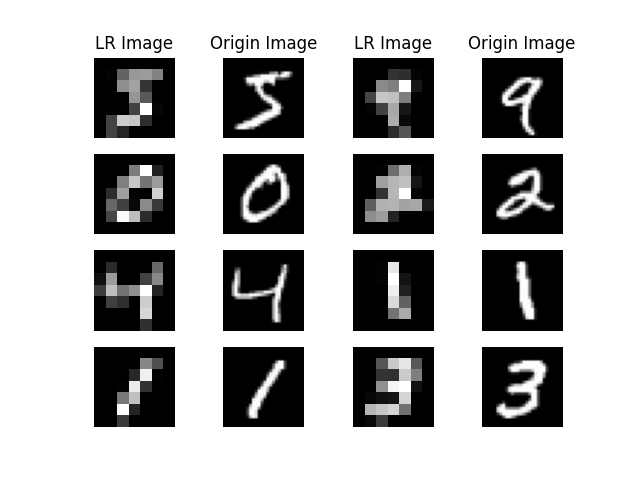
以下是資料處理完整的程式部份
def load_data(self,used_data_num=10000):
(x_train, _), (_, _) = mnist.load_data()
x_train = x_train[:used_data_num,:,:] #處理60000張照片比較久,故使用10000張照片就好
x_train = (x_train / 127.5)-1
x_train = x_train.reshape((-1, 28, 28, 1))
#先處理第一張照片,之後的照片再用迴圈一筆一筆添加,否則在空的array中直接append shape會跑掉
#處理完的shape是(7,7)
lr_x_train = cv2.resize(x_train[0], (7, 7), interpolation=cv2.INTER_AREA).reshape((1,7,7,1))
for i in range(1, used_data_num):
print(f'\rDestroying the images... finish:{round(i/100,3)}%', end='')
img = cv2.resize(x_train[i], (7, 7), interpolation=cv2.INTER_AREA)
lr_x_train = np.append(arr=lr_x_train, values=img.reshape(1,7,7,1), axis=0)
self.show_processed_image(img=x_train, processed_img=lr_x_train)
return x_train, lr_x_train
另外也有展示圖片經過處理後的結果,這部分跟前天的Pix2Pix類似:
def show_processed_image(self, img, processed_img):
l_x_train = (processed_img + 1) / 2
x_train = (img + 1) / 2
fig, axs = plt.subplots(4, 4)
count = 0
axs[0, 0].set_title('LR Image')
axs[0, 1].set_title('Origin Image')
axs[0, 2].set_title('LR Image')
axs[0, 3].set_title('Origin Image')
for i in range(4):
axs[i, 0].imshow(l_x_train[count, :, :, 0], cmap='gray') # 低解析度圖片
axs[i, 0].axis('off')
axs[i, 1].imshow(x_train[count, :, :, 0], cmap='gray') # 原始圖片
axs[i, 1].axis('off')
axs[i, 2].imshow(l_x_train[count + 4, :, :, 0], cmap='gray') # 低解析度圖片
axs[i, 2].axis('off')
axs[i, 3].imshow(x_train[count + 4, :, :, 0], cmap='gray') # 原始圖片
axs[i, 3].axis('off')
count += 1
plt.show()
接下來就要來建立SRGAN了,經過幾次實驗以後發現SRGAN也使用類似PatchGAN的方式訓練效果會更不錯,所以SRGAN的判別器也會判斷許多小圖片。
在判別器建立時會動一點歪腦筋,使用判別器的"部分網路"作為特徵提取 (Feature Net)的網路,程式碼中是self.fn,這個網路會取代VGG用於計算感知損失。
class SRGAN():
def __init__(self, generator_lr, discriminator_lr):
if not os.path.exists('./result/SRGAN/imgs'):
os.makedirs('./result/SRGAN/imgs')
self.generator_lr = generator_lr
self.discriminator_lr = discriminator_lr
#建立判別器與特徵提取(fn)的網路
self.discriminator, self.fn = self.build_discriminator()
self.generator = self.build_generator()
self.adversarial = self.build_adversarialmodel()
self.discriminator_patch = (7, 7, 1)
self.gloss = []
self.dloss = []
接著就要來定義模型了,SRGAN的作者很貼心給了網路架構的完整圖,但是我們的圖片並不會太大,所以也會適當的降低模型的層數與參數量。
生成器:生成器根據原始論文描述使用PReLU,並使用一些殘差區塊 (Residual Block),殘差區塊使用卷積-批次正規化-PReLU-卷積-批次正規化BN-跳接組成。
來複習一下昨天原始論文提及到的模型架構,我將殘差簡化到剩兩個,神經元參數量與卷積核大小都有縮小,下方的C1、r、C2、x可以對照到程式碼範例中我定義的網路層:
def build_generator(self):
def UpSampling(input_, unit, kernel_size, strides=2):
x = Conv2DTranspose(unit, kernel_size=kernel_size, strides=strides, padding='same')(input_)
x = PReLU()(x)
return x
def Residual_Block(input_, unit):
x = Conv2D(unit, kernel_size=2, strides=1, padding='same')(input_)
x = BatchNormalization(momentum=0.8)(x)
x = PReLU()(x)
x = Conv2D(unit, kernel_size=2, strides=1, padding='same')(x)
x = BatchNormalization(momentum=0.8)(x)
x = Add()([x, input_])
return x
input_ = Input(shape=(7, 7, 1))
c1 = Conv2D(32, kernel_size=3, strides=1, padding='same')(input_)
c1 = PReLU()(c1)
r = Residual_Block(c1, 32)
r = Residual_Block(r, 32)
c2 = Conv2D(32, kernel_size=2, strides=1, padding='same')(r)
c2 = PReLU()(c2) #後來發現這層應該是BN,但訓練效果也還不錯
c2 = Add()([c2, c1])
x = UpSampling(c2, 64, kernel_size=2)
x = UpSampling(x, 64, kernel_size=2)
out = Conv2DTranspose(1, kernel_size=2, strides=1, padding='same', activation='tanh')(x)
model = Model(inputs=input_, outputs=out, name='Generator')
model.summary()
plot_model(model=model,to_file='./result/SRGAN/Generator.png',show_shapes=True)
return model
生成器網路架構圖如下,一樣使用plot_model()方法繪出的:
判別器:接著來看看判別器,判別器很簡單就是卷積-批次正規化BN-LeakyReLU結合的 (第一層沒有使用BN),經過幾層後直接接到全連接層然後一個LeakyReLU再使用一個全連接層+sigmoid做輸出。
根據論文,我們可以適時做些修改並建立模型,以更符合實際任務需求。這邊我們發現經過下採樣三次後有一個feature,那是作為特徵提取網路用的輸出,經過了四個下採樣後得到的特徵就是圖片的特徵圖,我們將輸入層與feature額外作為一個模型,這個模型不用特別編譯。就算未經訓練,他的參數計算對於假圖或者真圖來說都是公平的,不會因為今天輸入假圖,參數就會變動等等。
接著判別器就正常建立並編譯就好了,最後要返回兩個模型分別是判別器與特徵提取網路以供訓練使用。
不過此方法在訓練圖片大一點的資料集就幾乎沒用了。所以使用解析度大一點的圖片還是要使用VGG模型來提取特徵喔。
def build_discriminator(self):
def DownSampling(input_, unit, kernel_size, strides=1, bn=True):
x = Conv2D(unit, kernel_size=kernel_size, strides=strides, padding='same')(input_)
x = LeakyReLU(alpha=0.2)(x)
if bn:
x = BatchNormalization(momentum=0.8)(x)
return x
input_ = Input(shape=(28, 28, 1))
x = DownSampling(input_, unit=32, kernel_size=2, bn=False)
x = DownSampling(x, unit=32, kernel_size=2, strides=2)
x = DownSampling(x, unit=64, kernel_size=2)
feature = DownSampling(x, unit=64, kernel_size=2, strides=2) #特徵網路的輸出,是為取代VGG網路用的
x = Dense(128)(feature)
x = LeakyReLU(alpha=0.2)(x)
out = Dense(1, activation='sigmoid')(x)
fn_model = Model(inputs=input_, outputs=feature, name='fn') #取代VGG網路的特徵網路
model = Model(inputs=input_, outputs=out, name='Discriminator')
dis_optimizer = Adam(learning_rate=self.discriminator_lr , beta_1=0.5)
model.compile(loss='mse',
optimizer=dis_optimizer,
metrics=['accuracy'])
model.summary()
plot_model(model=model, to_file='./result/SRGAN/Discriminator.png', show_shapes=True)
return model, fn_model
編譯完模型後繪圖,下圖就是判別器模型的圖。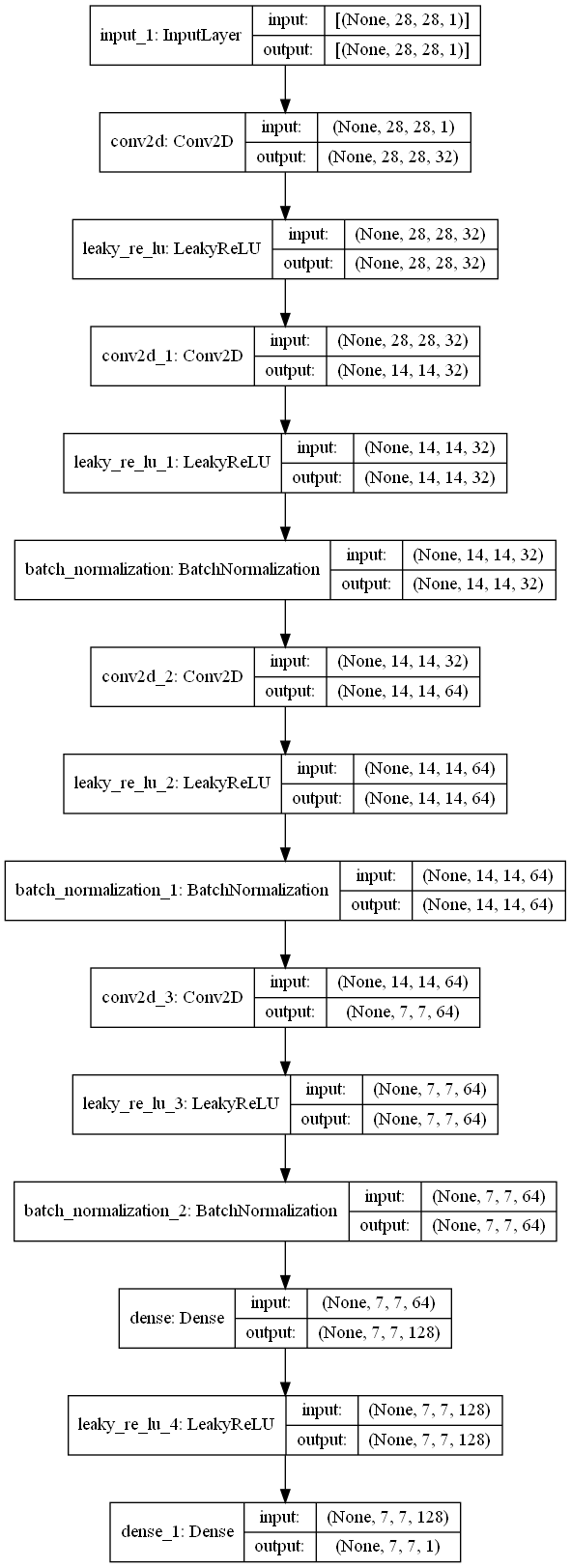
對抗模型:對抗模型建立上也沒有太複雜,只是也要將特徵圖作為輸出,好讓生成器可以比較感知損失。根據昨天介紹的SRGAN的目標函數,我們可以指定兩個損失函數的權重:
上式意思是總損失中,感知損失 (Contect loss, 使用MSE)加權為1;對抗損失 (Adversarial loss, 使用Binary CrossEntropy)加權為0.001。
def build_adversarialmodel(self):
lr_image_input = Input(shape=(7, 7, 1))
generator_sample = self.generator(lr_image_input)
self.discriminator.trainable = False
out = self.discriminator(generator_sample)
#得到生成圖片的特徵(feature map)
generator_sample_features = self.fn(generator_sample)
model = Model(inputs=lr_image_input, outputs=[out, generator_sample_features])
adv_optimizer = Adam(learning_rate=self.generator_lr, beta_1=0.5)
model.compile(loss=['binary_crossentropy','mse'], loss_weights=[0.001, 1], optimizer=adv_optimizer)
plot_model(model=model, to_file='./result/SRGAN/Adversarial.png', show_shapes=True)
model.summary()
return model
訓練步驟:訓練時與GAN差不多,只需要注意要記得提取真實圖片的特徵,並讓它作為對抗模型的答案,讓生成器訓練時也要去計算生成圖片的感知損失即可。基本上訓練都差不多是這樣,除了一些特定步驟要注意一下,GAN的訓練絕大部分都大同小異。
生成器訓練的損失有三個,第一個是損失加總、第二個是交叉熵 (未經過加權)、第三個是感知損失,即L2損失 (未經過加權)。
def train(self, epochs, batch_size=128, sample_interval=50):
# 準備訓練資料
x_train, lr_x_train= self.load_data()
valid = np.ones((batch_size,) + self.discriminator_patch)
fake = np.zeros((batch_size,) + self.discriminator_patch)
for epoch in range(epochs):
idx = np.random.randint(0, x_train.shape[0], batch_size)
imgs = x_train[idx]
lr_imgs = lr_x_train[idx]
gen_imgs = self.generator.predict(lr_imgs)
d_loss_real = self.discriminator.train_on_batch(imgs, valid)
d_loss_fake = self.discriminator.train_on_batch(gen_imgs, fake)
d_loss = 0.5 * np.add(d_loss_real, d_loss_fake)
self.dloss.append(d_loss[0])
image_features = self.fn(imgs) #使用特徵提取網路提取真實圖片的特徵
g_loss = self.adversarial.train_on_batch(lr_imgs, [valid, image_features])
self.gloss.append(g_loss)
print(f"Epoch:{epoch} [D loss: {d_loss[0]}, acc: {100 * d_loss[1]:.2f}] [G loss: Total:{g_loss[0]:.4f}, crossentropy loss:{g_loss[1]:.4f}, L2 loss:{g_loss[2]:.6f}]")
if epoch % sample_interval == 0:
self.sample(epoch)
self.save_data()
儲存資料的部分老樣子了:
def save_data(self):
np.save(file='./result/SRGAN/generator_loss.npy',arr=np.array(self.gloss))
np.save(file='./result/SRGAN/discriminator_loss.npy', arr=np.array(self.dloss))
save_model(model=self.generator,filepath='./result/SRGAN/Generator.h5')
save_model(model=self.discriminator,filepath='./result/SRGAN/Discriminator.h5')
save_model(model=self.adversarial,filepath='./result/SRGAN/Adversarial.h5')
繪製訓練過程的程式碼也差不多就那樣,以低清圖-生成圖-真實圖去檢視生成圖片的進步。
def sample(self, epoch=None, num_images=9, save=True):
r = int(np.sqrt(num_images))
idx = [10, 20, 30] #手動隨機挑三張照片,比較好觀察變化
x_train, lr_x_train = self.load_data(used_data_num=100)
lr_x_train = lr_x_train[idx]
x_train = x_train[idx]
gen_imgs = self.generator.predict(lr_x_train)
gen_imgs = (gen_imgs+1)/2
fig, axs = plt.subplots(r, r)
count = 0
axs[0, 0].set_title('LR Image')
axs[0, 1].set_title('Generative image')
axs[0, 2].set_title('Real image')
for i in range(r):
axs[i, 0].imshow(lr_x_train[count, :, :, 0], cmap='gray') #低清圖片
axs[i, 0].axis('off')
axs[i, 1].imshow(gen_imgs[count, :, :, 0], cmap='gray') #生成圖片
axs[i, 1].axis('off')
axs[i, 2].imshow(x_train[count, :, :, 0], cmap='gray') #真實圖片
axs[i, 2].axis('off')
count += 1
if save:
fig.savefig(f"./result/SRGAN/imgs/{epoch}epochs.png")
else:
plt.show()
plt.close()
訓練時我發現大概3000次訓練就可以訓練完成了,速度相當快:
超參數設定的部分如下表:
| 參數 | 參數值 |
|---|---|
| 生成器學習率 | 0.0002 |
| 判別器學習率 | 0.0002 |
| Batch Size | 64 |
| 訓練次數 | 3000 |
if __name__ == '__main__':
gan = SRGAN(generator_lr=0.0002,discriminator_lr=0.0002)
gan.train(epochs=3000, batch_size=64, sample_interval=200)
gan.sample(save=False)
來看看訓練的損失吧,可以看到生成器損失震盪非常大,但這不影響生成器生圖的品質。我們可以看到L2損失那條綠色的線也逐漸降低,雖然有一些震盪,但整體明顯有感覺到收斂。大概100多次訓練後L2損失才開始降低,那時候生成圖片的品質才開始變好。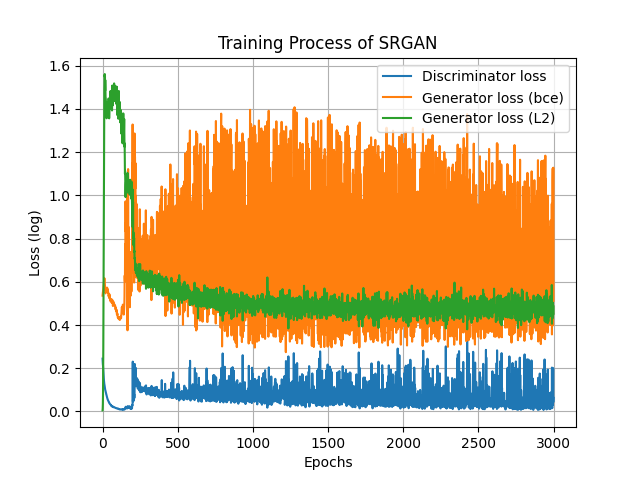
接著就來看看訓練過程吧,因為SRGAN訓練次數較少,所以會著重在前幾次的圖片生成,讓各位觀察看看訓練的變化。
Epoch=20,雜訊。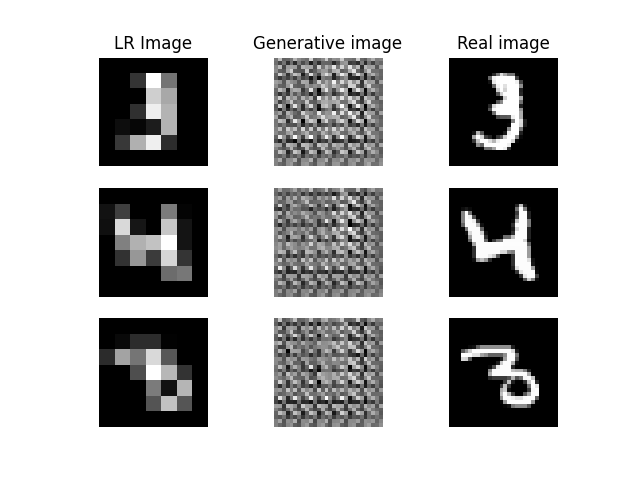
Epoch=100,有輪廓,但不多。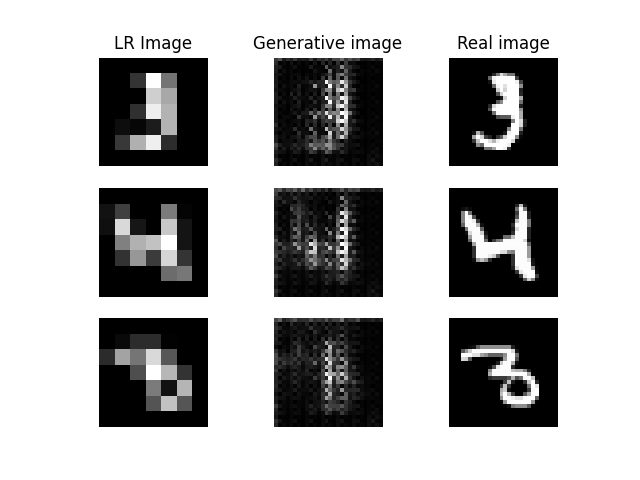
Epoch=200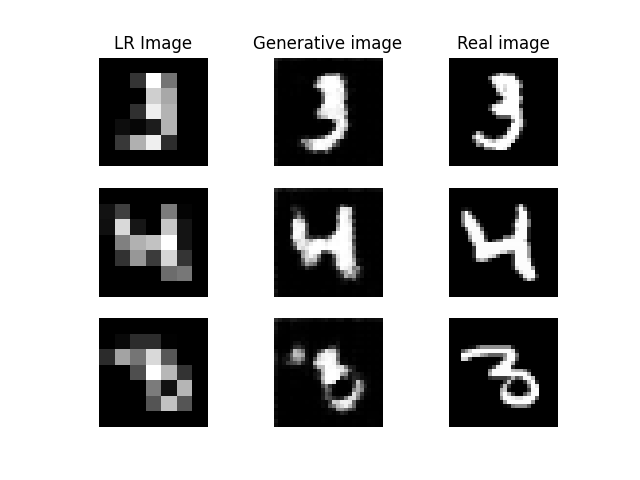
Epoch=1000
Epoch=3000,其實已經很不錯了。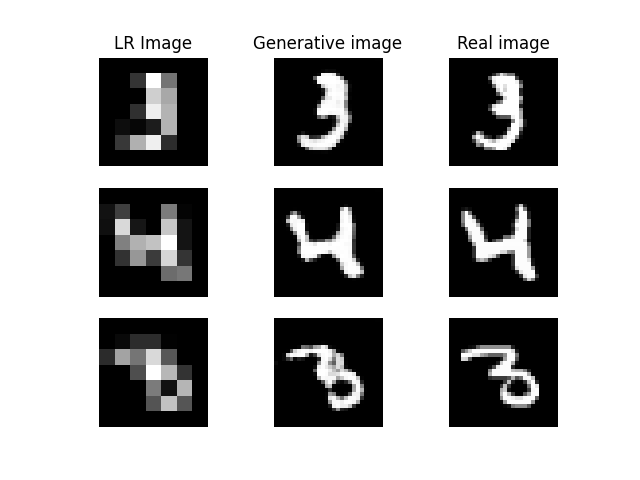
最後也是給各位看看生成圖片的變化,我覺得還蠻好看的:
今天帶個為時做了SRGAN,原則上GAN的實作就到此為止了。明天會介紹其他的GAN,各位有時間的話也可以去實作看看那些GAN,基本上我在建立GAN的流程就不外乎是這幾步了。若各位對GAN的建立還沒有甚麼概念的話也歡迎參考我其他文章喔!
from tensorflow.keras.datasets import mnist
from tensorflow.keras.layers import Input, BatchNormalization, LeakyReLU, Conv2DTranspose, Conv2D, PReLU, Add, Dense
from tensorflow.keras.models import Model, save_model
from tensorflow.keras.optimizers import Adam
import matplotlib.pyplot as plt
import numpy as np
import os
import cv2 #匯入OpenCV
from tensorflow.keras.utils import plot_model
from tensorflow.keras.applications import VGG19 #匯入VGG模型,但這次不會用到
class SRGAN():
def __init__(self, generator_lr, discriminator_lr):
if not os.path.exists('./result/SRGAN/imgs'):
os.makedirs('./result/SRGAN/imgs')
self.generator_lr = generator_lr
self.discriminator_lr = discriminator_lr
self.discriminator, self.fn = self.build_discriminator()
self.generator = self.build_generator()
self.adversarial = self.build_adversarialmodel()
self.discriminator_patch = (7, 7, 1)
self.gloss = []
self.dloss = []
def show_processed_image(self, img, processed_img):
l_x_train = (processed_img + 1) / 2
x_train = (img + 1) / 2
fig, axs = plt.subplots(4, 4)
count = 0
axs[0, 0].set_title('LR Image')
axs[0, 1].set_title('Origin Image')
axs[0, 2].set_title('LR Image')
axs[0, 3].set_title('Origin Image')
for i in range(4):
axs[i, 0].imshow(l_x_train[count, :, :, 0], cmap='gray') # 低解析度圖片
axs[i, 0].axis('off')
axs[i, 1].imshow(x_train[count, :, :, 0], cmap='gray') # 原始圖片
axs[i, 1].axis('off')
axs[i, 2].imshow(l_x_train[count + 4, :, :, 0], cmap='gray') # 低解析度圖片
axs[i, 2].axis('off')
axs[i, 3].imshow(x_train[count + 4, :, :, 0], cmap='gray') # 原始圖片
axs[i, 3].axis('off')
count += 1
plt.show()
def load_data(self,used_data_num=10000):
(x_train, _), (_, _) = mnist.load_data()
x_train = x_train[:used_data_num,:,:] #處理60000張照片比較久,故使用10000張照片就好
x_train = (x_train / 127.5)-1
x_train = x_train.reshape((-1, 28, 28, 1))
#先處理第一張照片,之後的照片再用迴圈一筆一筆添加,否則在空的array中直接append shape會跑掉
#處理完的shape是(7,7)
lr_x_train = cv2.resize(x_train[0], (7, 7), interpolation=cv2.INTER_AREA).reshape((1,7,7,1))
for i in range(1, used_data_num):
print(f'\rDestroying the images... finish:{round(i/100,3)}%', end='')
img = cv2.resize(x_train[i], (7, 7), interpolation=cv2.INTER_AREA)
lr_x_train = np.append(arr=lr_x_train, values=img.reshape(1,7,7,1), axis=0)
self.show_processed_image(img=x_train, processed_img=lr_x_train)
return x_train, lr_x_train
def build_generator(self):
def UpSampling(input_, unit, kernel_size, strides=2):
x = Conv2DTranspose(unit, kernel_size=kernel_size, strides=strides, padding='same')(input_)
x = PReLU()(x)
return x
def Residual_Block(input_, unit):
x = Conv2D(unit, kernel_size=2, strides=1, padding='same')(input_)
x = BatchNormalization(momentum=0.8)(x)
x = PReLU()(x)
x = Conv2D(unit, kernel_size=2, strides=1, padding='same')(x)
x = BatchNormalization(momentum=0.8)(x)
x = Add()([x, input_])
return x
input_ = Input(shape=(7, 7, 1))
c1 = Conv2D(32, kernel_size=3, strides=1, padding='same')(input_)
c1 = PReLU()(c1)
r = Residual_Block(c1, 32)
r = Residual_Block(r, 32)
c2 = Conv2D(32, kernel_size=2, strides=1, padding='same')(r)
c2 = PReLU()(c2) #後來發現這層應該是BN,但訓練效果也還不錯
c2 = Add()([c2, c1])
x = UpSampling(c2, 64, kernel_size=2)
x = UpSampling(x, 64, kernel_size=2)
out = Conv2DTranspose(1, kernel_size=2, strides=1, padding='same', activation='tanh')(x)
model = Model(inputs=input_, outputs=out, name='Generator')
model.summary()
plot_model(model=model,to_file='./result/SRGAN/Generator.png',show_shapes=True)
return model
def build_discriminator(self):
def DownSampling(input_, unit, kernel_size, strides=1, bn=True):
x = Conv2D(unit, kernel_size=kernel_size, strides=strides, padding='same')(input_)
x = LeakyReLU(alpha=0.2)(x)
if bn:
x = BatchNormalization(momentum=0.8)(x)
return x
input_ = Input(shape=(28, 28, 1))
x = DownSampling(input_, unit=32, kernel_size=2, bn=False)
x = DownSampling(x, unit=32, kernel_size=2, strides=2)
x = DownSampling(x, unit=64, kernel_size=2)
feature = DownSampling(x, unit=64, kernel_size=2, strides=2) #特徵網路的輸出,是為取代VGG網路用的
x = Dense(128)(feature)
x = LeakyReLU(alpha=0.2)(x)
out = Dense(1, activation='sigmoid')(x)
fn_model = Model(inputs=input_, outputs=feature, name='fn') #取代VGG網路的特徵網路
model = Model(inputs=input_, outputs=out, name='Discriminator')
dis_optimizer = Adam(learning_rate=self.discriminator_lr , beta_1=0.5)
model.compile(loss='mse',
optimizer=dis_optimizer,
metrics=['accuracy'])
model.summary()
plot_model(model=model, to_file='./result/SRGAN/Discriminator.png', show_shapes=True)
return model, fn_model
def build_adversarialmodel(self):
lr_image_input = Input(shape=(7, 7, 1))
generator_sample = self.generator(lr_image_input)
self.discriminator.trainable = False
out = self.discriminator(generator_sample)
#得到生成圖片的特徵(feature map)
generator_sample_features = self.fn(generator_sample)
model = Model(inputs=lr_image_input, outputs=[out, generator_sample_features])
adv_optimizer = Adam(learning_rate=self.generator_lr, beta_1=0.5)
model.compile(loss=['binary_crossentropy','mse'], loss_weights=[0.001, 1], optimizer=adv_optimizer)
plot_model(model=model, to_file='./result/SRGAN/Adversarial.png', show_shapes=True)
model.summary()
return model
def train(self, epochs, batch_size=128, sample_interval=50):
# 準備訓練資料
x_train, lr_x_train= self.load_data()
valid = np.ones((batch_size,) + self.discriminator_patch)
fake = np.zeros((batch_size,) + self.discriminator_patch)
for epoch in range(epochs):
idx = np.random.randint(0, x_train.shape[0], batch_size)
imgs = x_train[idx]
lr_imgs = lr_x_train[idx]
gen_imgs = self.generator.predict(lr_imgs)
d_loss_real = self.discriminator.train_on_batch(imgs, valid)
d_loss_fake = self.discriminator.train_on_batch(gen_imgs, fake)
d_loss = 0.5 * np.add(d_loss_real, d_loss_fake)
self.dloss.append(d_loss[0])
image_features = self.fn(imgs) #使用特徵提取網路提取真實圖片的特徵
g_loss = self.adversarial.train_on_batch(lr_imgs, [valid, image_features])
self.gloss.append(g_loss)
print(f"Epoch:{epoch} [D loss: {d_loss[0]}, acc: {100 * d_loss[1]:.2f}] [G loss: Total:{g_loss[0]:.4f}, crossentropy loss:{g_loss[1]:.4f}, L2 loss:{g_loss[2]:.6f}]")
if epoch % sample_interval == 0:
self.sample(epoch)
self.save_data()
def save_data(self):
np.save(file='./result/SRGAN/generator_loss.npy',arr=np.array(self.gloss))
np.save(file='./result/SRGAN/discriminator_loss.npy', arr=np.array(self.dloss))
save_model(model=self.generator,filepath='./result/SRGAN/Generator.h5')
save_model(model=self.discriminator,filepath='./result/SRGAN/Discriminator.h5')
save_model(model=self.adversarial,filepath='./result/SRGAN/Adversarial.h5')
def sample(self, epoch=None, num_images=9, save=True):
r = int(np.sqrt(num_images))
idx = [10, 20, 30] #手動隨機挑三張照片,比較好觀察變化
x_train, lr_x_train = self.load_data(used_data_num=100)
lr_x_train = lr_x_train[idx]
x_train = x_train[idx]
gen_imgs = self.generator.predict(lr_x_train)
gen_imgs = (gen_imgs+1)/2
fig, axs = plt.subplots(r, r)
count = 0
axs[0, 0].set_title('LR Image')
axs[0, 1].set_title('Generative image')
axs[0, 2].set_title('Real image')
for i in range(r):
axs[i, 0].imshow(lr_x_train[count, :, :, 0], cmap='gray') #低清圖片
axs[i, 0].axis('off')
axs[i, 1].imshow(gen_imgs[count, :, :, 0], cmap='gray') #生成圖片
axs[i, 1].axis('off')
axs[i, 2].imshow(x_train[count, :, :, 0], cmap='gray') #真實圖片
axs[i, 2].axis('off')
count += 1
if save:
fig.savefig(f"./result/SRGAN/imgs/{epoch}epochs.png")
else:
plt.show()
plt.close()
if __name__ == '__main__':
gan = SRGAN(generator_lr=0.0002,discriminator_lr=0.0002)
gan.train(epochs=3000, batch_size=64, sample_interval=200)
gan.sample(save=False)
